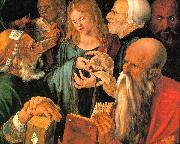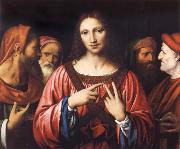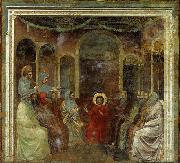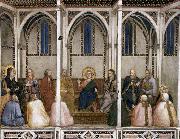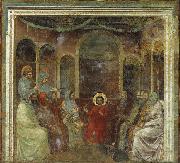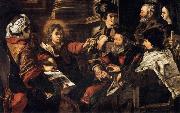Wholesale Oil Painting No Minimum |
|||||||||||
|
|
|||||||||||

|
|||||||||||
|
|
|
||||||||
Albrecht Durerb.May 21, 1471, Imperial Free City of Nernberg [Germany] d.April 6, 1528, Nernberg Albrecht Durer (May 21, 1471 ?C April 6, 1528) was a German painter, printmaker and theorist from Nuremberg. His still-famous works include the Apocalypse woodcuts, Knight, Death, and the Devil (1513), Saint Jerome in his Study (1514) and Melencolia I (1514), which has been the subject of extensive analysis and interpretation. His watercolours mark him as one of the first European landscape artists, while his ambitious woodcuts revolutionized the potential of that medium. D??rer introduction of classical motifs into Northern art, through his knowledge of Italian artists and German humanists, have secured his reputation as one of the most important figures of the Northern Renaissance. This is reinforced by his theoretical treatise which involve principles of mathematics, perspective and ideal proportions. His prints established his reputation across Europe when he was still in his twenties, and he has been conventionally regarded as the greatest artist of the Renaissance in Northern Europe ever since. |
||||||||
|
|
||||||||
Christ Among the Doctors
Christ Among the Doctors Painting ID:: 1043 |
1506
Foundation Thyssen Bornemisza, Madrid 1506 Foundation Thyssen Bornemisza, Madrid |
|||||||
|
|
||||||||
LUINI, BernardinoItalian High Renaissance Painter, ca.1480-1532 Italian painter and draughtsman. He was one of the generation of Lombard painters active around 1500 who, influenced by Leonardo and Raphael, blended High Renaissance innovations with indigenous Milanese elements to create a Lombard Renaissance style. Luini's paintings were extremely popular with both collectors and critics from c. 1790 to the end of the 19th century. This widespread popularity, however, had unfortunate consequences: many of his frescoes were detached from their original settings, many of the panel paintings were transferred to canvas and other works were heavily restored. As a result few survive in a good state. About 700 works are attributed to Luini, but many of these attributions are over optimistic. |
||||||||
|
|
||||||||
|
|
Christ among the Doctors
Christ among the Doctors Painting ID:: 42990 |
mk170
circa 1520
Oil on poplar
72.4x85.7cm
mk170 circa 1520 Oil on poplar 72.4x85.7cm |
||||||
|
|
||||||||
GIOTTO di BondoneItalian Early Renaissance Painter, 1267-1337 Italian painter and designer. In his own time and place he had an unrivalled reputation as the best painter and as an innovator, superior to all his predecessors, and he became the first post-Classical artist whose fame extended beyond his lifetime and native city. This was partly the consequence of the rich literary culture of two of the cities where he worked, Padua and Florence. Writing on art in Florence was pioneered by gifted authors and, although not quite art criticism, it involved the comparison of local artists in terms of quality. The most famous single appreciation is found in Dante's verses (Purgatory x) of 1315 or earlier. Exemplifying the transience of fame, first with poets and manuscript illuminators, Dante then remarked that the fame of Cimabue, who had supposed himself to be the leader in painting, had now been displaced by Giotto. Ironically, this text was one factor that forestalled the similar eclipse of Giotto's fame, which was clearly implied by the poet. |
||||||||
|
|
||||||||
|
|
Christ among the Doctors
Christ among the Doctors Painting ID:: 44342 |
200 x 185 cm 200 x 185 cm |
||||||
|
|
||||||||
GIOTTO di BondoneItalian Early Renaissance Painter, 1267-1337 Italian painter and designer. In his own time and place he had an unrivalled reputation as the best painter and as an innovator, superior to all his predecessors, and he became the first post-Classical artist whose fame extended beyond his lifetime and native city. This was partly the consequence of the rich literary culture of two of the cities where he worked, Padua and Florence. Writing on art in Florence was pioneered by gifted authors and, although not quite art criticism, it involved the comparison of local artists in terms of quality. The most famous single appreciation is found in Dante's verses (Purgatory x) of 1315 or earlier. Exemplifying the transience of fame, first with poets and manuscript illuminators, Dante then remarked that the fame of Cimabue, who had supposed himself to be the leader in painting, had now been displaced by Giotto. Ironically, this text was one factor that forestalled the similar eclipse of Giotto's fame, which was clearly implied by the poet. |
||||||||
|
|
||||||||
|
|
Christ Among the Doctors
Christ Among the Doctors Painting ID:: 44374 |
1310
1310 |
||||||
|
|
||||||||
GIOTTO di BondoneItalian Early Renaissance Painter, 1267-1337 Italian painter and designer. In his own time and place he had an unrivalled reputation as the best painter and as an innovator, superior to all his predecessors, and he became the first post-Classical artist whose fame extended beyond his lifetime and native city. This was partly the consequence of the rich literary culture of two of the cities where he worked, Padua and Florence. Writing on art in Florence was pioneered by gifted authors and, although not quite art criticism, it involved the comparison of local artists in terms of quality. The most famous single appreciation is found in Dante's verses (Purgatory x) of 1315 or earlier. Exemplifying the transience of fame, first with poets and manuscript illuminators, Dante then remarked that the fame of Cimabue, who had supposed himself to be the leader in painting, had now been displaced by Giotto. Ironically, this text was one factor that forestalled the similar eclipse of Giotto's fame, which was clearly implied by the poet. |
||||||||
|
|
||||||||
|
|
Christ among the Doctors
Christ among the Doctors Painting ID:: 62986 |
1304-06 Fresco, 200 x 185 cm Cappella Scrovegni (Arena Chapel), Padua In a rich red robe, the little twelve-year-old Jesus sits in the temple and holds a discussion - as his gesture quite clearly indicates. The arches of the architecture seem to echo the young boy's speech and at the same time to concentrate events on him. The scribes listen closely and in doing so show quite different reactions. Only one of them is completely distracted by the appearance of the worried parents. Artist: GIOTTO di Bondone Painting Title: No. 22 Scenes from the Life of Christ: 6. Christ among the Doctors , 1301-1350 Painting Style: Italian , , religious 1304-06 Fresco, 200 x 185 cm Cappella Scrovegni (Arena Chapel), Padua In a rich red robe, the little twelve-year-old Jesus sits in the temple and holds a discussion - as his gesture quite clearly indicates. The arches of the architecture seem to echo the young boy's speech and at the same time to concentrate events on him. The scribes listen closely and in doing so show quite different reactions. Only one of them is completely distracted by the appearance of the worried parents. Artist: GIOTTO di Bondone Painting Title: No. 22 Scenes from the Life of Christ: 6. Christ among the Doctors , 1301-1350 Painting Style: Italian , , religious |
||||||
|
|
||||||||
SERODINE, GiovanniItalian Baroque Era Painter, 1600-1630 Italian painter and stuccoist. His family moved from Ascona on Lake Maggiore to Rome, where his father is recorded in 1595. It is probable that Serodine was born there. His first work was probably done in association with his brother Giovanni Battista Serodine (1589/90-1630), a stuccoist active in Rome, where he carved a Virgin and Child (1614) for the fa?ade of S Francesca Romana, and in Ascona, where he restored the family home and decorated it with stucco (1620). The design and stucco decoration of the church of the Madonna della Fortuna on Monte Verit? (Ascona) are attributed to him, though it is probable that Giovanni (who is recorded in Ascona in 1620) collaborated in the work. The first of Giovanni's documented official commissions, however, was for the stucco decoration and apsidal paintings in the chuch of the Concezione at Spoleto, where he worked with Sante Ghezzi (Corradini; Toscano). These murals, painted in tempera and completed in July 1624, are sketchy and clumsily executed, quite distinct in their inferior quality and naive piety from the rest of Serodine's work. They are probably his first attempts at painting, |
||||||||
|
|
||||||||
|
|
Christ among the Doctors
Christ among the Doctors Painting ID:: 96049 |
circa 1625(1625)
Medium oil on canvas
cyf circa 1625(1625) Medium oil on canvas cyf |
||||||
|
|
||||||||
|
SERODINE, Giovanni Italian Baroque Era Painter, 1600-1630 Italian painter and stuccoist. His family moved from Ascona on Lake Maggiore to Rome, where his father is recorded in 1595. It is probable that Serodine was born there. His first work was probably done in association with his brother Giovanni Battista Serodine (1589/90-1630), a stuccoist active in Rome, where he carved a Virgin and Child (1614) for the fa?ade of S Francesca Romana, and in Ascona, where he restored the family home and decorated it with stucco (1620). The design and stucco decoration of the church of the Madonna della Fortuna on Monte Verit? (Ascona) are attributed to him, though it is probable that Giovanni (who is recorded in Ascona in 1620) collaborated in the work. The first of Giovanni's documented official commissions, however, was for the stucco decoration and apsidal paintings in the chuch of the Concezione at Spoleto, where he worked with Sante Ghezzi (Corradini; Toscano). These murals, painted in tempera and completed in July 1624, are sketchy and clumsily executed, quite distinct in their inferior quality and naive piety from the rest of Serodine's work. They are probably his first attempts at painting, Christ among the Doctors circa 1625(1625) Medium oil on canvas cyf |
||||||||
|
|
||||||||
|
Prev Next
|
||||||||
|
|
||||||||
|
Related Paintings to SERODINE, Giovanni :. |
||||||||
|
|
||||||||
|
CONTACT US |
